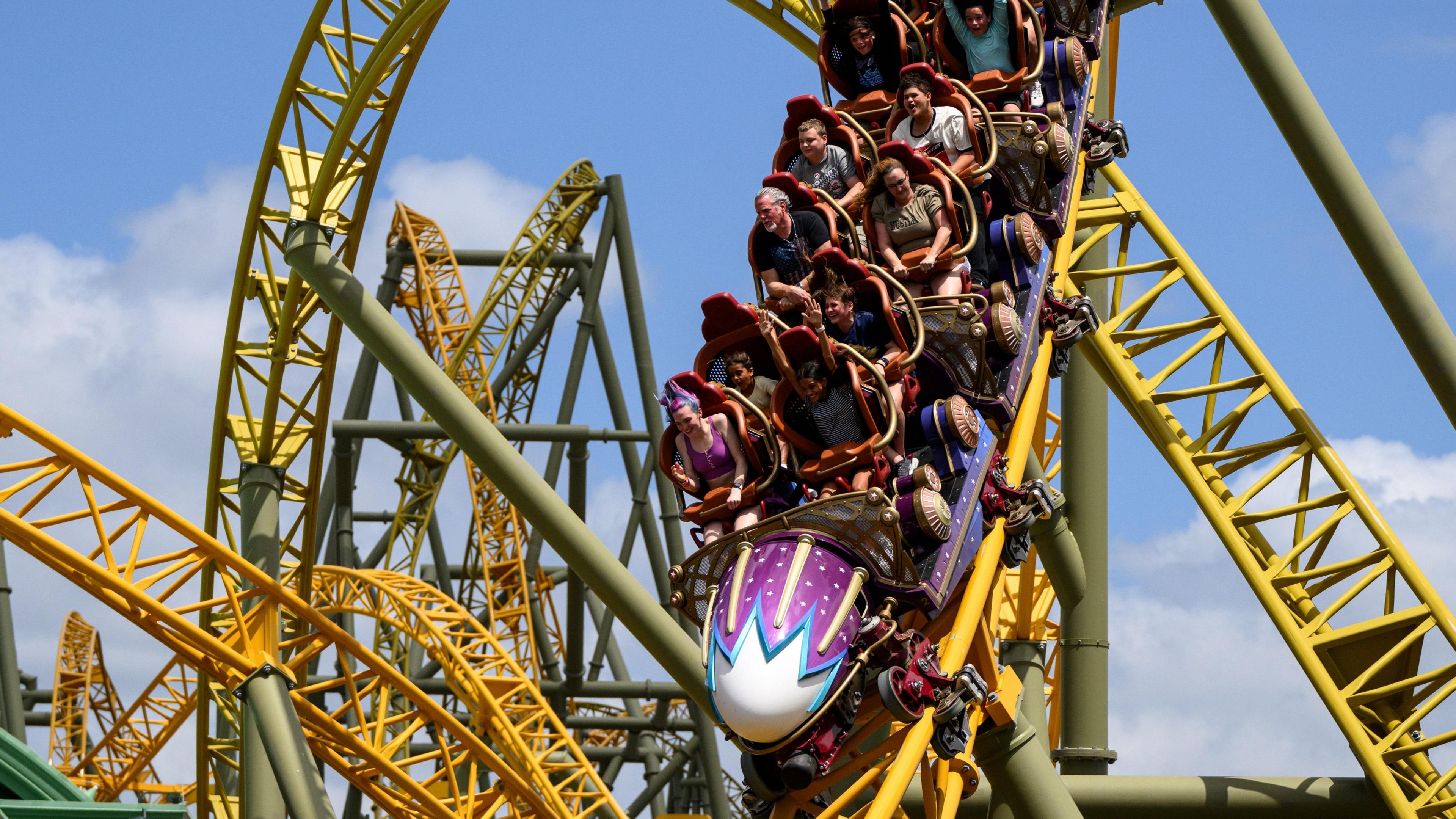Universal theme park is coming to the UK - so what could it look like?
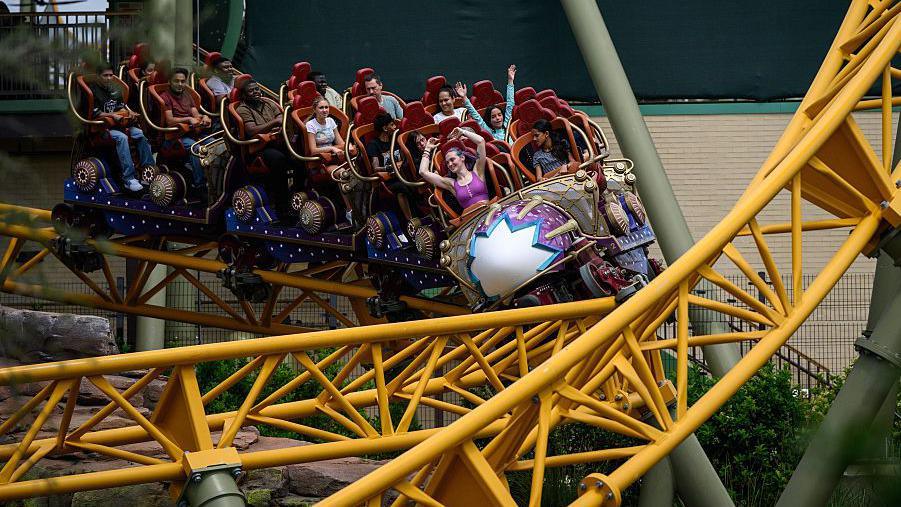
Universal's new Epic Universe theme park in Orlando offers a glimpse of what the UK's version could look like
- Published
A new Universal theme park near Bedford - the first in Europe - was announced to much fanfare earlier this week.
Set to open in 2031, construction is to begin at the 476-acre (1.9-sq-km) site, where attractions are likely to feature James Bond, Paddington and The Lord of the Rings.
But from deciding how many loops to include on a coaster, to making sure even the trees blend in seamlessly with an area's design, building a dream world is a painstaking task.
To find out what planning lies behind the thrills, and what sort of things we could expect when the new Universal park finally arrives, BBC News spoke to some rollercoaster experts.
Building an iconic rollercoaster
Of course, any good theme park needs some good rides - but maybe it's an understatement to say that's a tall order.
While "at least two or three iconic rides" are needed, these need not necessarily be the fastest, tallest or most innovative to stand out, explains Andy Sinclair-Harris, creative director at Katapult, which has designed attractions for the likes of Legoland and Alton Towers.
"What is more important is the depth of storytelling," he says, so that you're fully immersed in the experience of the ride.
A good example, says Robbie Jones, insights director at Katapult, is a Harry-Potter-themed rollercoaster called Hagrid's Magical Creatures Motorbike Adventure, located at The Wizarding World of Harry Potter in Universal's Orlando resort. Riders sit in replicas of Hagrid's motorbike and zoom through recreations of settings from the popular film series.
"There's nothing particularly brand new or absolutely amazing about that ride, other than it tells a story amazingly well," he adds.
How Universal Studios almost came to Essex
- Published13 April
Bond and Paddington could star at Universal park
- Published15 April
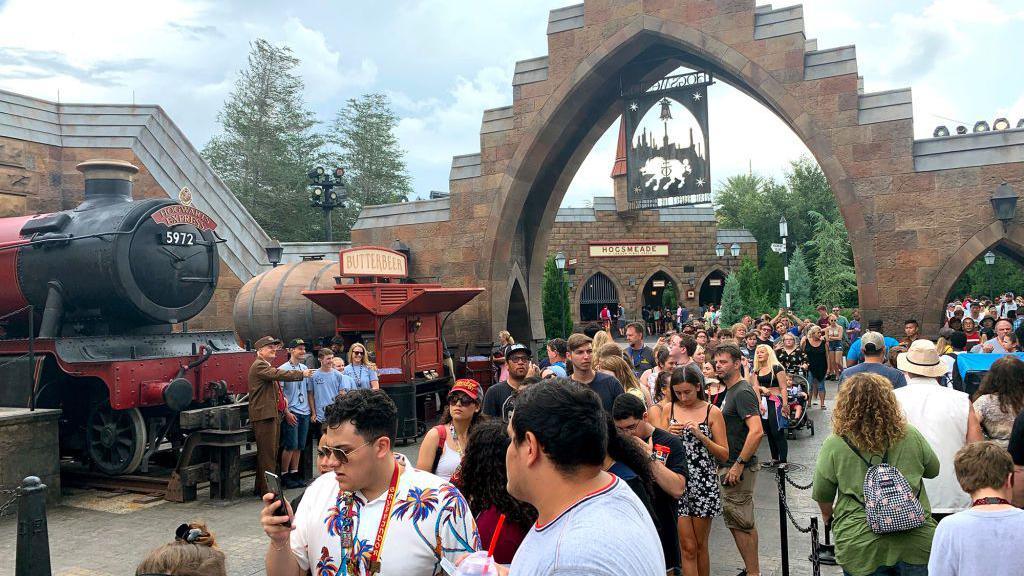
Universal says its Hagrid's Magical Creatures Motorbike Adventure is its most "immersive coaster"
If the rumours that there's going to be a Back to the Future ride at Universal's UK venture are true, those behind it will be ensuring that the DeLorean time machine is included, he says.
During the brainstorming stage of building a resort, rides are often "developed as storytelling tools" in a "specific genre or world", says Joseph Bright, CEO at Scruffy Dog, which provides creative project management for theme parks.
While an iconic ride might help to "anchor" a zone of a park, "it's never developed in isolation" - rather "cohesion is critical [and] every element... must serve the wider guest story".
Dennis Speigel, founder of International Theme Park Services, says meticulous planning goes into the most immersive rides.
He adds that the size of a rollercoaster is partly dictated by the number of guests its designers hope to get on board - "between 1,500 and 2,000 an hour" at popular parks.
Usually, that means a coaster that is over 3,000ft (914m) long, with the first dip "somewhere in the 150ft (45m) range".
Mr Speigel says that while an upcoming coaster at Six Flags Qiddiya in Saudi Arabia is set to break records when it sends riders speeding at over 150mph (240 km/h) around the tracks, most coasters today reach between 70-90mph (110-145 km/h) on their first drop.
Once the larger rides are planned out, theme park designers then consider what he describes as "flat rides", which cater to less thrill-seeking crowds.
"Those are your smaller rides that take people around and around, like a merry-go-round or a monster," he says. "[They're] rides that can often be bought off the shelf from a manufacturer."
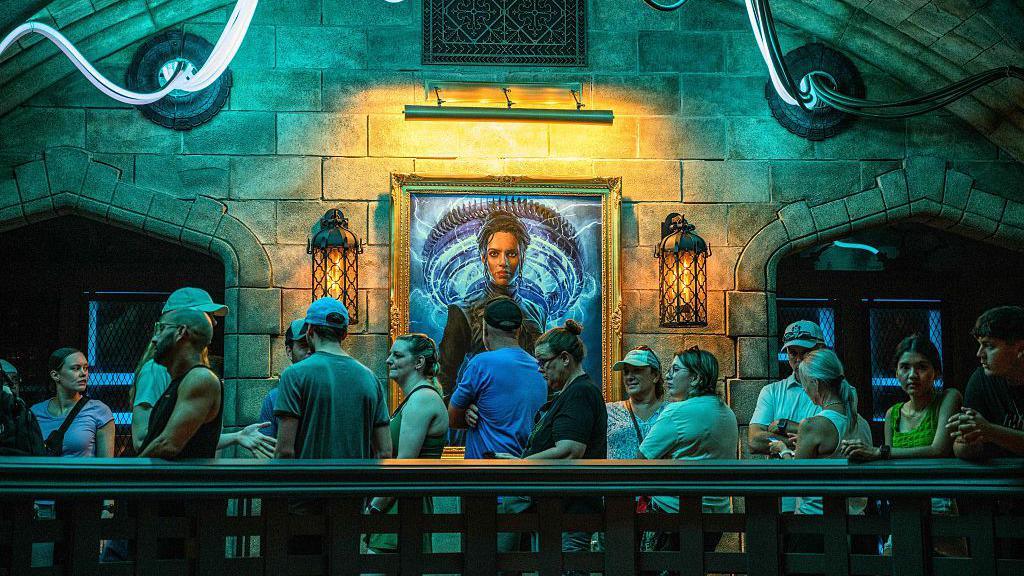
Guest wait in line for the Monsters Unchained: The Frankenstein Experiment at Epic Universe in Orlando, Florida
Your route to the ride is key
When you step foot in a theme park, you're probably thinking about the rides you'll be going on - but you might think less about how you get there.
During the design phase, you have to let your imagination run wild, says Mr Sinclair-Harris. "Budget is a thing, but when you have those first initial discussions, you shouldn't be tempered by anything," he says.
The "story" of your park is crucial, he adds. "It's knowing the story, the characters and being true to that world."
Discussions about potential ride dimensions and manufacturers soon follow, as well as a masterplan, which configures how attractions, pathways and amenities all fit into the space. It often determines how long people will end up queuing for.
An artist's conception of the Universal UK park depicts a huge lake in middle of what appears to be different themed areas. Far from just looking pretty, it can allow crowds to fan out to multiple rides without congestion forming around one.
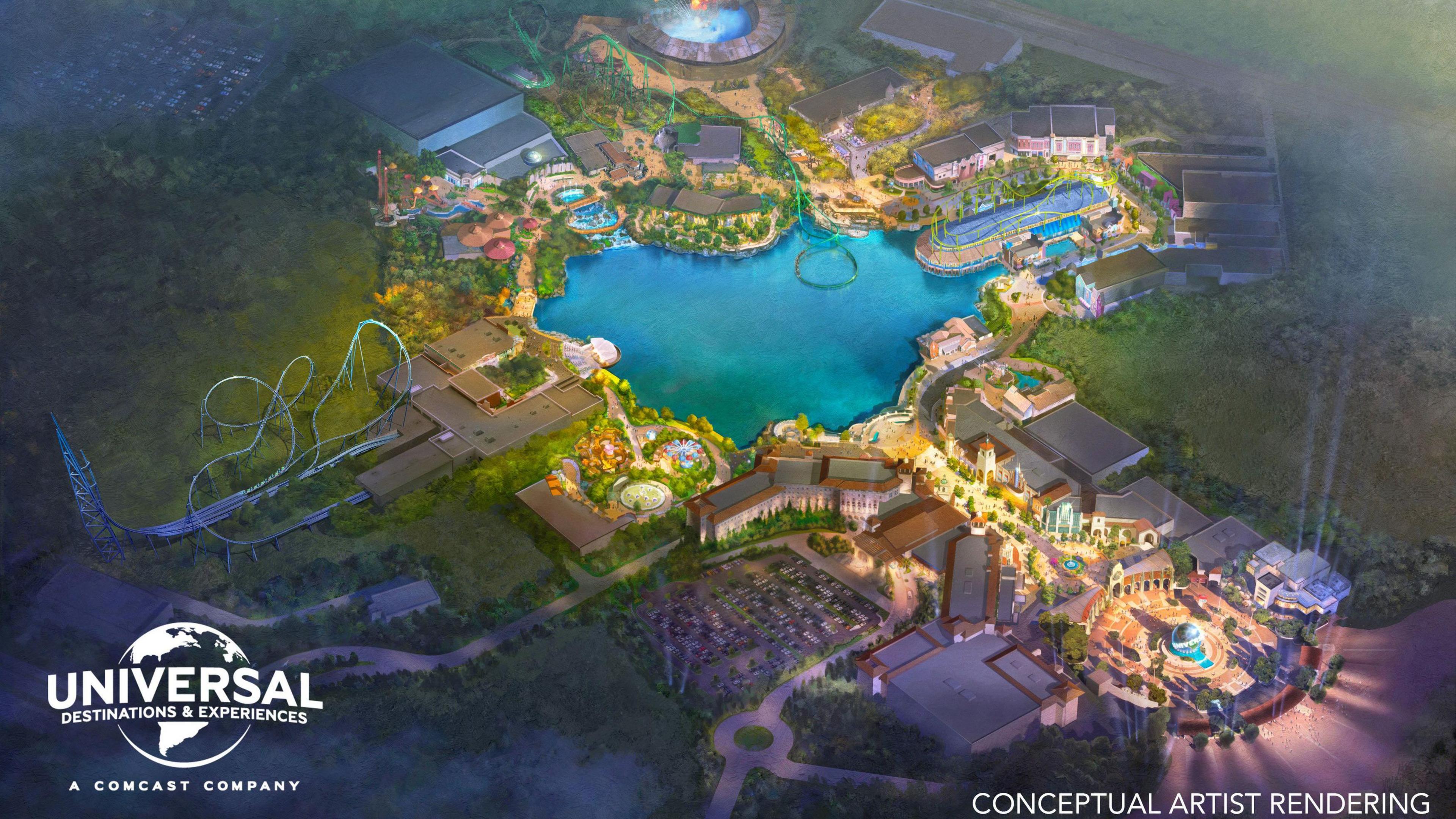
An artist's depiction of what the new Universal theme park could look like
Alton Towers has a lake too. Theme park vlogger and fanatic Charlotte Branford - known as Diary of a RollerCoaster Girl - believes it means other visitors often choose to go left around it (to the Wicker Man ride), or right around it (towards the Smiler). She heads to the back of the park to try to avoid the crowds.
At the back of parks designed in this way you'll often find a show with set times "to try and stop people running around to the back of the park to get to some big attraction", says Justin Garvanovic, founder of the European Coaster Club, who has been involved in rollercoaster designs.
"Without realising it, they're trying to make you do roughly what they want you to do when you're in the park."
Another tried and tested layout is the "hub and spoke" often seen at Disneyland resorts, says Mr Sinclair-Harris.
"In a sense you've got that central gathering point... like the castle in the Magic Kingdom... with different lands like spokes on a wheel, radiating out."
Universal's new Epic Universe theme park in Orlando will follow a version of this - allowing you to venture into different lands through portals.

Universal's new Epic Universe theme park in Orlando will see guests transport to different lands through 'portals'
The finer details
So the stories behind the rollercoasters are intertwined with the story of the theme park layout itself.
Then come the finishing touches - to maintain your sense of being in a futuristic or fantasy world while you're there.
Trees, artificial rock or even other buildings are often used to obscure unsightly but necessary objects, Mr Sinclair-Harris says. "If you're in an amazing world with castles and dragons, seeing a telephone pole removes you from that story".
Even the audio playing out, scent of a park and queue lines are considered because they "play a role in that illusion," says Mr Bright.
As Mr Garvanovic puts it, "there's tons of subtle stuff going on in the background" in a well thought-out theme park.
The sign of success, perhaps, is when you barely even notice it.
Related topics
- Published15 April
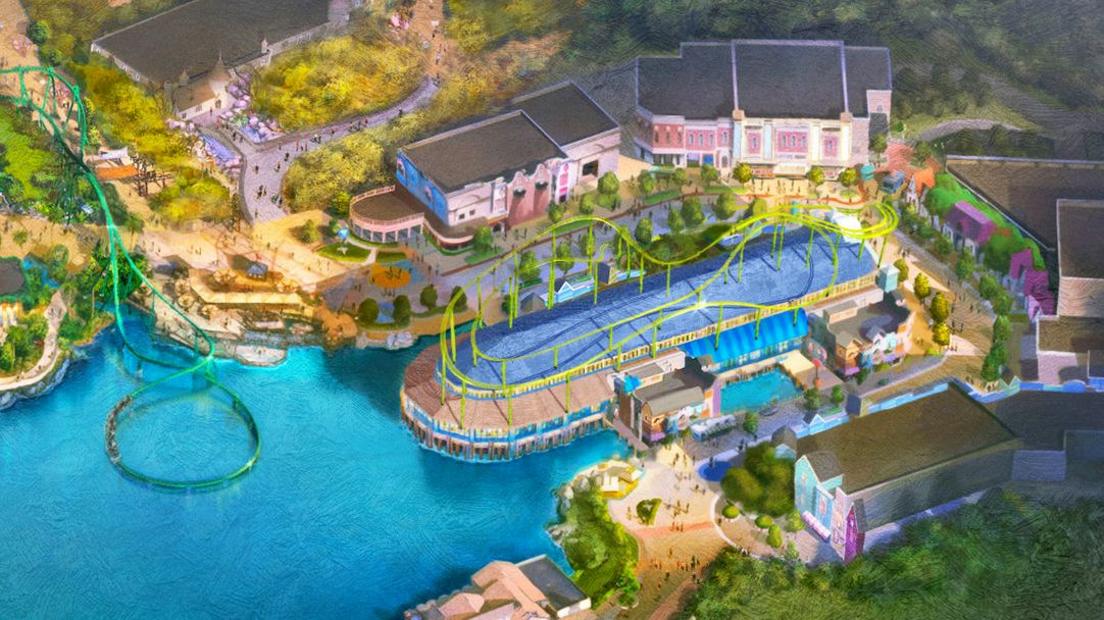
- Published15 April
